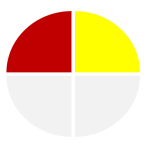7.4 Colour Combinations
Different DISC colours often align or clash based on whether they are task-oriented or relationship-oriented and whether they lean toward introversion or extroversion.
| Dimension | Task-Oriented | Relationship-Oriented |
|---|---|---|
| Focus | Completing tasks, goals, and productivity | Building and maintaining interpersonal relationships |
| Communication Style | Direct, structured | Empathetic, people-focused |
| Decision-Making | Based on logic and efficiency | Considers emotions and group harmony |
| Motivation | Driven by achievement and outcomes | Driven by team cohesion and morale |
| Dimension | Introversion | Extroversion |
|---|---|---|
| Energy Source | Solitude, reflection | Social interaction, external stimulation |
| Preferred Activities | Quiet, focused work | Group activities, collaboration |
| Communication Style | Thoughtful, reserved | Expressive, talkative |
| Reaction to Stress | Withdraws to recharge | Seeks interaction or distraction |
The following sections illustrate how certain pairings naturally complement one another while others pose more challenges.
Complimentary Combinations
 Red & Yellow (extroverted)
Red & Yellow (extroverted)
| Shared Strengths | Potential Friction |
| Both move at a fast pace. Results drive Reds, while Yellows are energized by social interaction. This combination can spark dynamic teamwork, as Red’s focus on achievement pairs well with Yellow’s enthusiasm and interpersonal skills. | Red might perceive Yellow as disorganized or unfocused, while Yellow could find Red overly forceful or pushy. |
 Green & Blue (introverted)
Green & Blue (introverted)
| Shared Strengths | Potential Friction |
| Both are more reflective and can find common ground in thoughtful decision-making. Given adequate time and space, they can work together calmly and efficiently. | Blue’s analytical critiques might feel harsh to Green, who values a supportive atmosphere. Meanwhile, Green’s reluctance to push ahead may frustrate Blue’s desire for prompt, logical resolutions. |
 Red & Blue (task-oriented)
Red & Blue (task-oriented)
| Shared Strengths | Potential Friction |
| Both value efficiency and logical problem-solving. Together, they can be highly productive, focusing on structured tasks and outcomes. | Red’s preference for rapid decision-making can clash with Blue’s need for detailed, precise, methodical analysis. |
 Yellow & Green (relationship-oriented)
Yellow & Green (relationship-oriented)
| Shared Strengths | Potential Friction |
| Both prioritize harmony and positive interactions. Yellows thrive on social engagement, while Greens provide calm, supportive stability, creating a friendly, cohesive environment. | Green’s desire for consistency may clash with Yellow’s spontaneous approach, resulting in misunderstandings if Yellow’s unstructured style overwhelms Green. |
Challenging Combinations
 Red & Green
Red & Green
Potential Conflict: Red is direct, fast-paced, extroverted, and focused on results, while Green values harmony, stability, and collaboration. Red may view Green as too passive or hesitant, while Green may see Red as aggressive or dismissive.
Key Challenges:
- Red prefers quick decisions, while Green wants consensus and emotional security.
- Red values efficiency, while Green values relationships and comfort in their work environment.
- Green may become overwhelmed by Red’s blunt, task-oriented style, leading to withdrawal or disengagement.
Solution: Red should slow down, show empathy, and acknowledge Green’s need for a supportive environment, while Green should express concerns assertively rather than avoiding conflict.
 Blue & Yellow
Blue & Yellow
Potential Conflict: Blue values precision, structure, and logic, while Yellow thrives on enthusiasm, creativity, and social energy. Blue may see Yellow as scattered and unfocused, while Yellow may feel restricted by Blue’s need for detailed analysis.
Key Challenges:
- Blue is methodical and cautious, whereas Yellow is spontaneous and people-driven.
- Blue needs facts and accuracy, while Yellow is more big-picture and instinct-driven.
- Yellow may struggle with Blue’s preference for rules and order, while Blue may be frustrated by Yellow’s lack of attention to detail.
Solution: Blue should recognize Yellow’s strength in generating ideas and engaging others, while Yellow should respect Blue’s need for structure and provide clear reasoning for their ideas rather than relying solely on enthusiasm.

